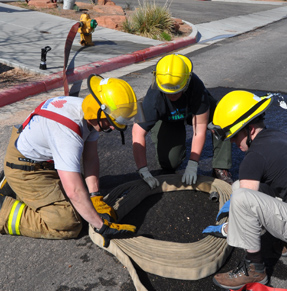This is the second in a series about two structural fire academy candidates, Brandon Penrose and David Robinson, park rangers from Grand Canyon National Park. Their stories have been blended together.
“What? Day 3 and I'm already responding to calls? It's time to show what we have learned!”

Day 2 — Hundreds of Gallons of Water per Minute
Today at the structural fire academy we learned about hoses for the first time. The morning lecture consisted of an overview of fire mechanics and various pieces of plumbing that connect hoses together. Although this was “dry” subject matter, it was presented in a no-nonsense manner, which made it more interesting. Following the morning lecture, all firefighters met out on the fireground to learn how to roll and package hose properly on an engine.
“You will get tired of learning how to re-stack hose, but you will be good at it,” stated one instructor. “During a fire, the hose is your way to help people and property, and without having it set up correctly or being laid down properly, it will not deploy properly in the time of need.”
During the last two hours of the day, we actually got to charge hose lines and spray water for the first time. We learned to spray different patterns, and about team tactics for fire attack. There is nothing like having hundreds of gallons of water per minute flowing through your hands, causing recoil that pushes you and your team backwards. If you aren't careful, it will knock you over. The hose is much heavier with water, and it takes at least three people to handle it. And if you want to advance the hose any considerable distance, you'd better call in the cavalry for help.
I feel pretty confident after the second day and am looking forward to putting these skills to use fighting real fire later on in the week.
Day 3 — The First Scenario
“Engine 81, please respond to 123 Boring Lane for a report of a fire in the kitchen.” What? Day 3 and I'm already responding to calls? It's time to show what we have learned! There is a lot to think about when traveling to a fire scene. What kind of hose are we grabbing, what tools, are we going to vent, are there people inside, how fast is the fire spreading, do we need a foam application, where is the hydrant, should we do a forward lay or a reverse lay?
Once we're on site, we move fast, getting off the engine, grabbing that minuteman hose pack, going toward the fire as the hose flakes off your shoulder, placing it on the ground, signaling for water to charge your hose, securing the hose with a knee, donning SCBA and turning on air, selecting the pattern, ensuring proper GPM (gallons per minute). Have a second person on the hose, and you are ready to attack this fire. Now, all those steps take about, oh, two minutes. Every step needs to be fast, efficient, and safe. Becoming more familiar with the equipment will ensure that the process can and will go faster and smoother. This day was all about scenarios and being able to take different roles during those scenarios. Surprisingly, with only two days of training under our belts, today's exercise shows that we have been learning something.
Part of a series of articles titled Structural Firefighting Academy.
Previous: Learning the Basics, Part 1
Last updated: December 2, 2016
